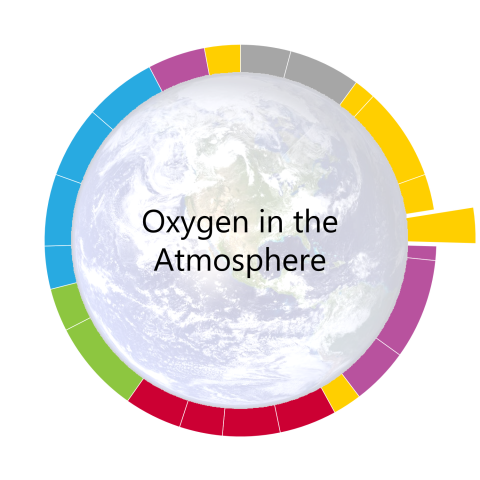
Phenomenon
The oxygen content of the atmosphere changed over Earth’s history from nearly 0% to it’s present level of nearly 21%.
Question
Where did the oxygen in the atmosphere come from? Why did the level change?
Model Ideas
- Oxygen is one of the most abundant elements on Earth, but it didn’t occur as a gas in the early atmosphere.
- Some kinds of life release oxygen as a gas as a result of some life processes.
- Oxygen is a highly reactive substance and combines readily with other molecules to form new compounds.
- As life became more abundant on Earth oxygen was released into the atmosphere but most of it quickly reacted with other substances and therefore did not build up in the atmosphere for a long time (as much as a billion years).
- Around 2.5 billion years ago it began accumulating in the atmosphere as evidenced by banded iron formations
- As life continued to become more abundant and moved onto land the atmospheric oxygen increased and stabilized to modern levels of approximately 21%.
- At the end of the triangle, we'll more broadly recognize that Earth's systems or "spheres" influence one another.
Overview
Transition In: After imagining an Earth with both atmosphere and oceans, we recognize the stage has been set for the evolution of life. But we're still wondering when and how life comes to out planet.
In searching for the origins of life, we review the state of the early Earth. In comparing to where we are now, we recognize that Earth's systems have changed over time. We investigate one particular change, the increase in atmospheric oxygen from almost nothing to it's current level making up nearly 21% of the mass of the air we breathe. The pattern of change shows an initial increase billions of years ago, followed by a long state of low oxygen and then a more recent climb to the levels present over the past hundreds of millions of years. How can we explain this pattern of change?
We offer some initial ideas but realize we need to learn more about oxygen. We learn it is the most abundant element on our planet, but that it is highly reactive. In studying oxidation and considering photosynthesis as an explanatory mechanism for putting oxygen into the air, we begin to piece together a story that explains our increase-plateau-increase pattern. The model invokes both oxygen's reactivity and the origin and diversification of life on Earth.
In this way we see not only that Earth's "spheres" change over time, but that they influence one another.
Transition Out: Recognizing the advent of life on the planet leads us to finally move into our study of biology, which begins with a consideration of extant biodiversity.
Advanced Planning
There are several options for demos and labs depending on how long you want to spend and how you want to structure this unit for your students. This model includes whole class processing of two ideas related to chemical processes--photosynthesis and oxidation--and then small group processing of some additional data about timing of life and info from the geologic record (card sorts). There are easy labs or demonstrations that could be done for photosynthesis and oxidation if you want your students to have more hands-on lab time. We provide supports in the curricular materials for a "rust demo" and a link to a video demonstrating the role of oxygen in photosynthesis. The materials needed for each can be found on the "Supplies Details and Ordering" tab on the Advanced Planning spreadsheet available from the Advanced Planning page on this site.
Download Resources
| Attachment | Size |
|---|---|
| All Resources for Oxygen in the Atmosphere | 11.86 MB |